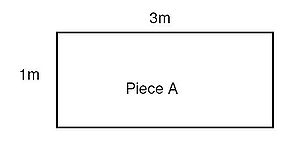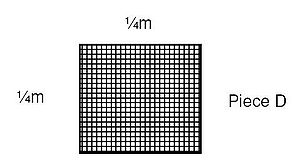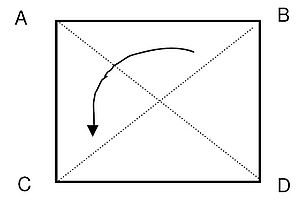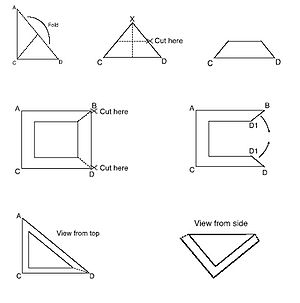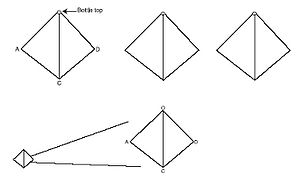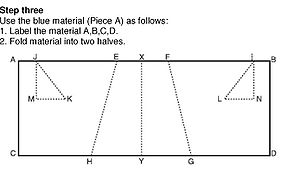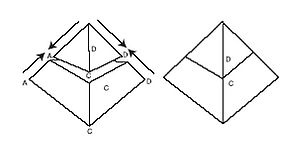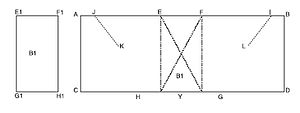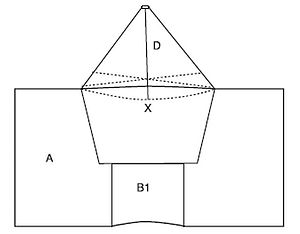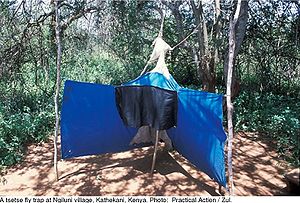Difference between revisions of "How to Make a Tsetse Fly Trap"
(Blanked the page) |
|||
| Line 1: | Line 1: | ||
| + | TSETSE FLY MANAGEMENT | ||
| + | ===THROUGH USE OF TRAPPING TECHNOLOGY === | ||
| + | ====Introduction ==== | ||
| + | This brief describes community-based tsetse fly control as a drought management strategy in tsetse fly invaded areas, which are settled by agro-pastoralists. | ||
| + | Agro-pastoralists may be described as settled pastoralists who cultivate sufficient areas to feed their families from their own crop production. Agro-pastoralists hold land rights, use their own or hired labour to cultivate land and grow staples. While livestock are still valued property, their herds are on average smaller than other pastoral systems, possibly because they no longer solely rely on livestock and depend on a finite grazing area around their village which can be reached within a day. | ||
| + | ===='''Importance of disease control strategies '''==== | ||
| + | |||
| + | Livestock production is a more dependable livelihood option for rural communities in arid and semi-arid areas. Livestock have the ability to withstand effects of adverse climatic occurrences, especially droughts and, therefore provide both food and income security. Nevertheless, disease often constrain successful livestock production in drought stress. | ||
| + | |||
| + | The animals, which are under nutritional as well as physical stress (resulting from movement over long distances in search water and pasture), succumb easily to diseases in times of severe drought. Disease management must be an integral part of a drought management strategy in order to help vulnerable communities of pastoralists and agro-pastoralists become more resilient to the frequently recurring drought shocks. The level and nature of disease management interventions is influenced by local or rangeland factors such as tsetse flies. | ||
| + | |||
| + | Parasitic diseases that affect livestock are widespread in sub-Saharan Africa, particularly in arid and semi-arid areas. One of the most serious parasitic diseases is trypanosomosis. This disease, which affects both human beings and livestock is transmitted by tsetse flies and covers approximately 10 million square kilometres in 38 African countries. This brief focuses on the control of the trypanosomosis in livestock. | ||
| + | |||
| + | With fewer resources to support livestock production, cost effective and sustainable methods of disease control must actively involve local communities. One of the methods of tsetse fly control is use of trapping technology. Although the trapping technology is the one described in this brief, other technology options of trypanosomosis and tsetse fly control are available. | ||
| + | |||
| + | |||
| + | |||
| + | |||
| + | |||
| + | ==== Methods in trypanosomosis and tsetse fly control==== | ||
| + | |||
| + | The control targets either the vector (tsetse fly) that transmits the parasite (trypanosomosis) that causes the disease. The following methods of control are often used. | ||
| + | |||
| + | o Use of drugs to cure and/or protect the animal | ||
| + | o Selection or breeding of animals that are resistant to trypanosomosis disease | ||
| + | o Selective clearing of bushes to destroy hiding and breeding places of tsetse flies | ||
| + | o Use of baited traps or treated targets | ||
| + | o Application of insecticides through prays, dips, pour-ons and aerial spraying | ||
| + | o Use of biological techniques such as Sterile Insect Technique (SIT) or predators | ||
| + | |||
| + | ''' ''' | ||
| + | |||
| + | This Technical Brief focuses on the use of baited fly traps. | ||
| + | |||
| + | |||
| + | |||
| + | |||
| + | |||
| + | ===='''Community-based tsetse fly trapping technology '''==== | ||
| + | |||
| + | Trapping technology, which is often enhanced with attractant odours that attract and kill tsetse flies, is relatively simple and less polluting to the environment than insecticide application. Traps are relatively inexpensive and lend themselves to community participation. However, problems are experienced due to trap theft, vandalism, and damage by wildlife. To reduce theft of traps and vandalism requires at the very least a high degree of community education and awareness-raising. Such community awareness can be extended further to community participation, involvement of local people in control activities, and even community-based systems, such as management and financing. | ||
| + | |||
| + | |||
| + | |||
| + | ===='''Community awareness raising '''==== | ||
| + | |||
| + | There are various ways in which this can be done: | ||
| + | |||
| + | |||
| + | |||
| + | ====='''Holding of meetings with local people '''===== | ||
| + | |||
| + | Within a relatively small or sparsely populated area the best way to inform the local people about the intended activities is to hold village meetings. Ideally, local leaders who know their area and the local language or dialect should do this. | ||
| + | |||
| + | A trap of the design to be used should be taken to the meetings, and set up for people to see. Several small meetings are always better than one big one, so that people feel free to ask questions. Meetings should be held at times to allow participation of most people from target community. | ||
| + | |||
| + | |||
| + | |||
| + | ====='''Talks to schools, and women’s groups '''===== | ||
| + | |||
| + | It is important to reach all sectors of the community, not only men, since it may be the women or children who have most contact with the traps when fetching water, firewood or herding cattle. Talks to local schools or women’s groups may succeed better in this respect than general meetings. | ||
| + | |||
| + | Schools are always grateful for any educational materials, especially if it helps with teaching their normal syllabus. Trap-making competitions are always popular, as are models, posters, and workbooks. T-shirts, badges or baseball caps with pictures, logos or simple messages, are popular and help spread the message. Any means of involving people in maintaining or running the control can help. Where people are settled, advantage should be taken of existing groups to help maintain and protect the traps. | ||
| + | |||
| + | |||
| + | |||
| + | ====='''Production of posters '''===== | ||
| + | |||
| + | Meetings and talks can be very effective within a relatively closed community. If, however, other people are regularly passing through, they will not have attended the meetings and will not know what the traps are for. Here, posters can be helpful, although they have to be very carefully produced. | ||
| + | |||
| + | As far as possible the message should be put over using pictures; any text should be in both the local and national languages. Poster designs should be checked with local people before large numbers are produced. Posters should be produced in materials that will survive the weather and displayed at various meeting places including markets, shops, schools, churches and water sources. | ||
| + | |||
| + | |||
| + | |||
| + | ====='''Use of the media '''===== | ||
| + | |||
| + | For large-scale programmes, it may be necessary to use the mass media, especially the radio, to reach enough people. Even in rural areas many of the community will own a radio. Interviews in the field are more interesting than ones conducted in the studio. | ||
| + | |||
| + | |||
| + | |||
| + | ====='''Community participation '''===== | ||
| + | |||
| + | Livestock owners are usually the most ready to participate. If they constitute the majority of the population, there is no problem, as they are probably become enthusiastic in order to gain personal financial benefits. Community participation is also much more successful if human populations are sedentary rather than migratory, and if they own their land and thus have the incentive of directly benefiting from the activities. | ||
| + | |||
| + | Community participation is sometimes viewed as a source of free or cheap labour. This is not a good approach. If local involvement is to be secured and sustained the benefits must be convincing to the participants and exceed the value of labour and other inputs. It is best if some people in the community are given paid employment in the control operations, in addition to any self-help component. This will not only provide employment, but will enable those employed to be trained in more depth on the approach. They can then spearhead community motivation, and act as a focus for these activities. | ||
| + | |||
| + | |||
| + | |||
| + | ===='''Involving local communities in development tsetse traps '''==== | ||
| + | Effective involvement of local communities in tsetse trap technology adoption requires that they acquire appropriate skills such as trap-making, site selection for trap deployment, trap deployment, and maintenance. Target communities must also be supported to acquire additional skills such as resource mobilization and management, leadership, and organizational management to enable target communities sustain tsetse-trapping activities beyond external support. | ||
| + | |||
| + | |||
| + | |||
| + | ===='''Making a tsetse fly trap Materials Requirement '''==== | ||
| + | |||
| + | 1. One piece of blue material measuring 3m x 1m (Piece A) | ||
| + | |||
| + | [[ File:tsetse_Image A.jpg|300px]] | ||
| + | |||
| + | 2. One piece of black material measuring 1m x ½m (Piece B1) | ||
| + | |||
| + | [[ File:tsetse_Image B1.jpg|300px]] | ||
| + | |||
| + | 3. One piece of black material measuring 1m x ½m (Piece B2) | ||
| + | |||
| + | 4. One piece of blue material measuring 1m x 1m (Piece C) | ||
| + | |||
| + | [[ File:tsetse_Image C.jpg|300px]] | ||
| + | |||
| + | 5. One piece of white netting material measuring ¼m x ¼m (Piece D) ¼m | ||
| + | |||
| + | [[ File:tsetse_Image D.jpg|300px]] | ||
| + | |||
| + | # Bottle top with a ½ inch pinch hole | ||
| + | |||
| + | [[ File:tsetse_fly_management_img_6.jpg|200px]] | ||
| + | |||
| + | # A transparent Polythene paper bag to act as a cage for holding tsetse catches | ||
| + | |||
| + | |||
| + | |||
| + | '''Step One ''' | ||
| + | |||
| + | |||
| + | [[File:tsetse_fly_management_img_8.jpg|300px]] | ||
| + | |||
| + | Use the blue material (Piece C) as follows: | ||
| + | |||
| + | # Label the material A, B, C, D | ||
| + | # Fold material diagonally to make a triangle | ||
| + | # Fold the triangle into two as shown | ||
| + | # Make point X touch CD | ||
| + | # Cut on the folded line parallel to CD | ||
| + | # Open the new shape | ||
| + | # Cut the points B -B1 and D -D1 | ||
| + | # Join B -B1 and D -D1 with staples | ||
| + | |||
| + | [[ File:tsetse_fly_management_img_10.jpg|300px]] | ||
| + | ====='''Step Two '''===== | ||
| + | |||
| + | Use the white netting (Piece D) as follows: | ||
| + | |||
| + | 1. Label the white netting material A, B, C, D and draw diagonal lines joining the points as shown | ||
| + | |||
| + | [[ File:tsetse_fly_management_img_12.jpg|300px]] | ||
| + | |||
| + | # Cut along the dotted line as shown | ||
| + | # Join the line O-B to O-D and staple them together | ||
| + | |||
| + | 5. Fix bottle top to the apex as shown </center> | ||
| + | |||
| + | [[ File:tsetse_fly_management_img_14.jpg|300px]] | ||
| + | |||
| + | 6. Join the white netting material (Piece D) to the final product of step 1 (Piece C) as shown | ||
| + | |||
| + | [[ File:tsetse_fly_management_img_16.jpg|300px]][[ File:tsetse_fly_management_img_17.jpg|300px]] | ||
| + | |||
| + | 3. Mark the mid point at the top X and the mid point at the bottom Y | ||
| + | |||
| + | 4. From point X measure 1/4m to the left and 1/4m to the right. | ||
| + | |||
| + | 5. Mark the points E and F respectively | ||
| + | |||
| + | 6. From point Y measure 1/2m to the left and 1/2m to the right | ||
| + | |||
| + | 7. Mark the point H and G | ||
| + | |||
| + | 8. Draw a line joining points E-H and F-G | ||
| + | |||
| + | 9. From point F measure 1m and mark the point I | ||
| + | |||
| + | 10. From point E measure 1m and | ||
| + | mark the point J | ||
| + | |||
| + | 11. From point J measure 1/2 m downwards and mark this point M | ||
| + | |||
| + | 12. From point I measure 1/2 m downwards and mark this point N | ||
| + | |||
| + | 13. From point M measure 1/4 m towards the right and mark it K | ||
| + | |||
| + | 14. Repeat the same for point N as shown and mark it L | ||
| + | |||
| + | 15. Draw lines joining points J-K and I-L | ||
| + | |||
| + | '''Step four ''' | ||
| + | |||
| + | Use the black material (Piece B1) as follows: | ||
| + | # Label the material E1,F1,G1,H1 as shown | ||
| + | # Fit E1 to E, F1 to F, G1 to G, and H1 to H | ||
| + | # Staple along EG and FH | ||
| + | |||
| + | [[ File:tsetse_fly_management_img_19.jpg|300px]] | ||
| + | |||
| + | |||
| + | '''Step five ''' | ||
| + | |||
| + | Use the black material (Pierce B2) as follows: | ||
| + | |||
| + | # Mark the material I1, J1 and L1 | ||
| + | # From point L1 measure 6 inches and fold the flap using staples. | ||
| + | # Repeat the same at point K1 | ||
| + | # Fit J1 to J, I1 to I, K1 to K, L1 to L and staple along J-K and I-L | ||
| + | |||
| + | [[ File:tsetse_fly_management_img_21.jpg|300px]] | ||
| + | |||
| + | |||
| + | [[ File:tsetse_fly_management_img_22.jpg|300px]] | ||
| + | |||
| + | 5. Join final product of step two to final product of step five with staples by fitting A C D to J X | ||
| + | |||
| + | [[ File:tsetse_fly_management_img_24.jpg|300px]] | ||
| + | |||
| + | '''Step six ''' | ||
| + | The following steps should be followed when setting up the Ngu trap: | ||
| + | |||
| + | * Clear the selected trap site of any vegetation | ||
| + | * Determine the wind direction so as to site the trap facing the windward side | ||
| + | * Erect a back pole to guide in setting up of two-side poles. Firmly peg the back poles. Fasten the trap with pieces of wire to the back poles. Peg in the two side poles and fasten the trap so that the entrance faces the proper direction. Prepare the centre pole by fixing three nails of three inches each with a clearance of two inches each at the top and peg it firmly. Fix the netting on bottle top and support it by the nails at the top of the centre pole. | ||
| + | * Fit the polythene cage at the apex of the erected trap and support the cage with strings stretched from thin sticks that are fastened on one of the side poles. | ||
| + | * Firmly fix two containers, one for carrying attractant liquid substance (acetone) on the ground next to the back pole and the other for carrying cow urine. The attractant container should be covered with a lid that has a small aperture for slowing down the releasing odours as the attractant evaporates. | ||
| + | * Fix transparent polythene bag to the top of the trap frame. The polythene bag is used as a cage for holding and suffocating tsetse flies. The sunlight attracts tsetse flies into the cage, which get killed by the heat from the sun. Dead flies in the cage or regularly disposed. For purposes of keeping records, tsetse fly catches are counted and recorded. The tsetse fly catches can also be sorted by age or sex for recording. | ||
| + | |||
| + | [[ File:tsetse_fly_management_img_26.jpg|300px]] | ||
| + | |||
| + | '''Selecting Tsetse Trap Sites ''' | ||
| + | Selection of trap sites is usually determined by the target species of tsetse fly. Generally traps are sited in shaded places, preferably under tree shades. Animal tracks should be avoided to protect traps from damage. | ||
| + | |||
| + | '''Maintaining Tsetse Fly Traps ''' | ||
| + | Once in place, traps must be visited regularly to ensure that they are still upright, that cloth are not torn or faded and that they are overgrown with bushes. The attractants must be refilled if depleted and tsetse fly catches be emptied if cages are filled. Trap Maintenance requires skills and knowledge about materials that are regularly replaced, quality considerations, procurement systems, repairs or replacement skills and site clearing of bushes. Since trap maintenance is essential for effective tsetse fly trapping, it important that local people are equipped with appropriate skills, which can be acquired through training workshops or exchange visits. Trap monitoring and maintenance training covers the following topics: | ||
| + | |||
| + | * Quality of repair or replacement materials | ||
| + | * Maintenance of repair equipment, including staplers | ||
| + | * Differentiation of tsetse fly sex or age | ||
| + | * Replenishment of attractants including acetone and urine | ||
| + | * Trap repair | ||
| + | * Information collection, including tsetse fly counts and recording | ||
| + | * Communication skills for effective dissemination of information to the wider community. | ||
| + | |||
| + | Community representatives who can be targeted for training include trap monitors, supervisors and owners of land (trap managers) where traps are set. | ||
| + | |||
| + | Depending on the number of traps and the area covered, each monitor is responsible for 10 to 25 traps and each supervisor is responsible for 10 to 15 trap-monitors. Trap monitors visit each trap once a month to check and record information on tsetse catches, empty the traps of tsetse catches, carry out repairs of any damaged parts of the trap, replenish odour bait (attractants). They also clear surrounding bushes, check with trap-managers for other general information related to traps and compile data on each trap visited. This information is passed on to supervisors who report to the local community management committee for required action. | ||
| + | |||
| + | Trap maintenance is a very demanding task and trap monitors and supervisors may require some form of remuneration. This will vary from one community to another depending on available project finances and local agreement among beneficiaries of community-based tsetse initiatives. Some community initiatives provide provided trap monitors and supervisors with bicycles with mutually agreed terms on usage and maintenance. Other community-based tsetse control initiatives pay trap monitors and supervisors for their work. | ||
| + | |||
| + | '''Monitoring and evaluation ''' | ||
| + | Community-based tsetse control initiatives should establish regular work schedules, a monitoring and community feedback system, which provide tangible results for decision-making. Evidence of tangible results such as tsetse catches, reduced cases of sick livestock, reduced usage of drugs and transparent accounting and record keeping all help to generate and sustain full community participation and contribution towards tsetse fly control activities. Trap catches are a good indicator of the success of the project. Project managers should emphasize the importance of record keeping in community-based tsetse control initiatives. Annual livestock census is essential in tracking trends in livestock numbers. An increase in livestock numbers indicates reduced mortality rates and farmers’ confidence in maintaining high numbers of livestock without fearing the risks of loss to trypanosomosis. Information about mortality rates is collected during annual livestock count and from government veterinary officers or community based animal health workers where possible. Records of community-based animal health workers or government/private veterinarians provide information about disease incidence. In addition, a sizeable herd (over 200 heads of cattle) of livestock should be identified and monitored over a period of time in order to determine infection rates through blood sampling and testing for trypanosomosis. Cases of trypanosomosis should be treated. Increasing community contribution of finances towards the tsetse control activities indicates local ownership, and commitment to sustaining tsetse control programmes. | ||
| + | |||
| + | '''References and further reading ''' | ||
| + | * ''Manual on Community-based Tsetse Control ''Community-based Livestock Initiatives Programme -CLIP, 2004, ISBN 9966 9775 5 4 | ||
| + | * TALC – Teaching-aids at Low Cost Flytrap | ||
| + | <u> http://www.talcuk.org/free/html/flytrap/flytrap.htm </u> | ||
| + | |||
| + | '''Links ''' | ||
| + | <u> http://www.tsetse.org/ </u> | ||
| + | Natural Resource Institute -Programmes and information to assist in the planning and implementation of tsetse control operations. | ||
| + | <u> http://www.nzitrap.com/index.htm </u> | ||
| + | "Nzi" is Swahili for fly. The Nzi trap is a simple, safe and economical cloth trap for the capture of biting flies (tsetse flies, horse flies, deer flies, stable flies). It was developed at <u> ICIPE </u> in Kenya as an environment-friendly alternative to the use of insecticides, following many years of research on appropriate and sustainable technology for African farmers. It is a passive killing device that works through the attraction of flies to large blue and black objects. Flies simply die from exposure after entering into an innovative configuration of cloth and netting. | ||
| + | |||
| + | '''Contacts ''' | ||
| + | Practical Action Eastern Africa, P.O. Box 39493, Nairobi, Kenya AAYMCA Building (Second Floor) Along State House Crescent Tel: +254 20 2715293 / 2719313 / 2719413 Fax: +254 20 710083 E-mail: <u> kenya@practicalaction.or.ke </u> | ||
| + | Arid Lands Information Network -ALIN P.O.Box 10098, 00100 G.P.O Nairobi Kenya AAYMCA Building, Ground Floor, Along State House Crescent Off State House Avenue Tel. +254 -20 -2731557 Fax: +254 -20 -2737813 Cell: +254 -20 -722 561006 E Mail: <u> info@alin.or.ke </u> Website: www.alin.or.ke | ||
| + | Community Animal Health Network Studio House, 4th Fl. Argwings Kodhek Road, Hurlingham | ||
| + | P.O. Box 49502, 00100, Nairobi Tel: 254 (20) 2731664/2732203 Mobile: +254 (2) 72157653/ 734721208 Fax: +254 (20) 2732086 E-mail: <u> info@cah-net.net </u> Website: www.cah-net.net | ||
Revision as of 19:25, 8 April 2010
TSETSE FLY MANAGEMENT
Contents
- 1 THROUGH USE OF TRAPPING TECHNOLOGY
- 1.1 Introduction
- 1.2 Importance of disease control strategies
- 1.3 Methods in trypanosomosis and tsetse fly control
- 1.4 Community-based tsetse fly trapping technology
- 1.5 Community awareness raising
- 1.6 Involving local communities in development tsetse traps
- 1.7 Making a tsetse fly trap Materials Requirement
THROUGH USE OF TRAPPING TECHNOLOGY
Introduction
This brief describes community-based tsetse fly control as a drought management strategy in tsetse fly invaded areas, which are settled by agro-pastoralists. Agro-pastoralists may be described as settled pastoralists who cultivate sufficient areas to feed their families from their own crop production. Agro-pastoralists hold land rights, use their own or hired labour to cultivate land and grow staples. While livestock are still valued property, their herds are on average smaller than other pastoral systems, possibly because they no longer solely rely on livestock and depend on a finite grazing area around their village which can be reached within a day.
Importance of disease control strategies
Livestock production is a more dependable livelihood option for rural communities in arid and semi-arid areas. Livestock have the ability to withstand effects of adverse climatic occurrences, especially droughts and, therefore provide both food and income security. Nevertheless, disease often constrain successful livestock production in drought stress.
The animals, which are under nutritional as well as physical stress (resulting from movement over long distances in search water and pasture), succumb easily to diseases in times of severe drought. Disease management must be an integral part of a drought management strategy in order to help vulnerable communities of pastoralists and agro-pastoralists become more resilient to the frequently recurring drought shocks. The level and nature of disease management interventions is influenced by local or rangeland factors such as tsetse flies.
Parasitic diseases that affect livestock are widespread in sub-Saharan Africa, particularly in arid and semi-arid areas. One of the most serious parasitic diseases is trypanosomosis. This disease, which affects both human beings and livestock is transmitted by tsetse flies and covers approximately 10 million square kilometres in 38 African countries. This brief focuses on the control of the trypanosomosis in livestock.
With fewer resources to support livestock production, cost effective and sustainable methods of disease control must actively involve local communities. One of the methods of tsetse fly control is use of trapping technology. Although the trapping technology is the one described in this brief, other technology options of trypanosomosis and tsetse fly control are available.
Methods in trypanosomosis and tsetse fly control
The control targets either the vector (tsetse fly) that transmits the parasite (trypanosomosis) that causes the disease. The following methods of control are often used.
o Use of drugs to cure and/or protect the animal o Selection or breeding of animals that are resistant to trypanosomosis disease o Selective clearing of bushes to destroy hiding and breeding places of tsetse flies o Use of baited traps or treated targets o Application of insecticides through prays, dips, pour-ons and aerial spraying o Use of biological techniques such as Sterile Insect Technique (SIT) or predators
This Technical Brief focuses on the use of baited fly traps.
Community-based tsetse fly trapping technology
Trapping technology, which is often enhanced with attractant odours that attract and kill tsetse flies, is relatively simple and less polluting to the environment than insecticide application. Traps are relatively inexpensive and lend themselves to community participation. However, problems are experienced due to trap theft, vandalism, and damage by wildlife. To reduce theft of traps and vandalism requires at the very least a high degree of community education and awareness-raising. Such community awareness can be extended further to community participation, involvement of local people in control activities, and even community-based systems, such as management and financing.
Community awareness raising
There are various ways in which this can be done:
Holding of meetings with local people
Within a relatively small or sparsely populated area the best way to inform the local people about the intended activities is to hold village meetings. Ideally, local leaders who know their area and the local language or dialect should do this.
A trap of the design to be used should be taken to the meetings, and set up for people to see. Several small meetings are always better than one big one, so that people feel free to ask questions. Meetings should be held at times to allow participation of most people from target community.
Talks to schools, and women’s groups
It is important to reach all sectors of the community, not only men, since it may be the women or children who have most contact with the traps when fetching water, firewood or herding cattle. Talks to local schools or women’s groups may succeed better in this respect than general meetings.
Schools are always grateful for any educational materials, especially if it helps with teaching their normal syllabus. Trap-making competitions are always popular, as are models, posters, and workbooks. T-shirts, badges or baseball caps with pictures, logos or simple messages, are popular and help spread the message. Any means of involving people in maintaining or running the control can help. Where people are settled, advantage should be taken of existing groups to help maintain and protect the traps.
Production of posters
Meetings and talks can be very effective within a relatively closed community. If, however, other people are regularly passing through, they will not have attended the meetings and will not know what the traps are for. Here, posters can be helpful, although they have to be very carefully produced.
As far as possible the message should be put over using pictures; any text should be in both the local and national languages. Poster designs should be checked with local people before large numbers are produced. Posters should be produced in materials that will survive the weather and displayed at various meeting places including markets, shops, schools, churches and water sources.
Use of the media
For large-scale programmes, it may be necessary to use the mass media, especially the radio, to reach enough people. Even in rural areas many of the community will own a radio. Interviews in the field are more interesting than ones conducted in the studio.
Community participation
Livestock owners are usually the most ready to participate. If they constitute the majority of the population, there is no problem, as they are probably become enthusiastic in order to gain personal financial benefits. Community participation is also much more successful if human populations are sedentary rather than migratory, and if they own their land and thus have the incentive of directly benefiting from the activities.
Community participation is sometimes viewed as a source of free or cheap labour. This is not a good approach. If local involvement is to be secured and sustained the benefits must be convincing to the participants and exceed the value of labour and other inputs. It is best if some people in the community are given paid employment in the control operations, in addition to any self-help component. This will not only provide employment, but will enable those employed to be trained in more depth on the approach. They can then spearhead community motivation, and act as a focus for these activities.
Involving local communities in development tsetse traps
Effective involvement of local communities in tsetse trap technology adoption requires that they acquire appropriate skills such as trap-making, site selection for trap deployment, trap deployment, and maintenance. Target communities must also be supported to acquire additional skills such as resource mobilization and management, leadership, and organizational management to enable target communities sustain tsetse-trapping activities beyond external support.
Making a tsetse fly trap Materials Requirement
1. One piece of blue material measuring 3m x 1m (Piece A)
2. One piece of black material measuring 1m x ½m (Piece B1)
3. One piece of black material measuring 1m x ½m (Piece B2)
4. One piece of blue material measuring 1m x 1m (Piece C)
5. One piece of white netting material measuring ¼m x ¼m (Piece D) ¼m
- Bottle top with a ½ inch pinch hole
- A transparent Polythene paper bag to act as a cage for holding tsetse catches
Step One
Use the blue material (Piece C) as follows:
- Label the material A, B, C, D
- Fold material diagonally to make a triangle
- Fold the triangle into two as shown
- Make point X touch CD
- Cut on the folded line parallel to CD
- Open the new shape
- Cut the points B -B1 and D -D1
- Join B -B1 and D -D1 with staples
Step Two
Use the white netting (Piece D) as follows:
1. Label the white netting material A, B, C, D and draw diagonal lines joining the points as shown
- Cut along the dotted line as shown
- Join the line O-B to O-D and staple them together
5. Fix bottle top to the apex as shown </center>
6. Join the white netting material (Piece D) to the final product of step 1 (Piece C) as shown
3. Mark the mid point at the top X and the mid point at the bottom Y
4. From point X measure 1/4m to the left and 1/4m to the right.
5. Mark the points E and F respectively
6. From point Y measure 1/2m to the left and 1/2m to the right
7. Mark the point H and G
8. Draw a line joining points E-H and F-G
9. From point F measure 1m and mark the point I
10. From point E measure 1m and mark the point J
11. From point J measure 1/2 m downwards and mark this point M
12. From point I measure 1/2 m downwards and mark this point N
13. From point M measure 1/4 m towards the right and mark it K
14. Repeat the same for point N as shown and mark it L
15. Draw lines joining points J-K and I-L
Step four
Use the black material (Piece B1) as follows:
- Label the material E1,F1,G1,H1 as shown
- Fit E1 to E, F1 to F, G1 to G, and H1 to H
- Staple along EG and FH
Step five
Use the black material (Pierce B2) as follows:
- Mark the material I1, J1 and L1
- From point L1 measure 6 inches and fold the flap using staples.
- Repeat the same at point K1
- Fit J1 to J, I1 to I, K1 to K, L1 to L and staple along J-K and I-L
5. Join final product of step two to final product of step five with staples by fitting A C D to J X
Step six The following steps should be followed when setting up the Ngu trap:
- Clear the selected trap site of any vegetation
- Determine the wind direction so as to site the trap facing the windward side
- Erect a back pole to guide in setting up of two-side poles. Firmly peg the back poles. Fasten the trap with pieces of wire to the back poles. Peg in the two side poles and fasten the trap so that the entrance faces the proper direction. Prepare the centre pole by fixing three nails of three inches each with a clearance of two inches each at the top and peg it firmly. Fix the netting on bottle top and support it by the nails at the top of the centre pole.
- Fit the polythene cage at the apex of the erected trap and support the cage with strings stretched from thin sticks that are fastened on one of the side poles.
- Firmly fix two containers, one for carrying attractant liquid substance (acetone) on the ground next to the back pole and the other for carrying cow urine. The attractant container should be covered with a lid that has a small aperture for slowing down the releasing odours as the attractant evaporates.
- Fix transparent polythene bag to the top of the trap frame. The polythene bag is used as a cage for holding and suffocating tsetse flies. The sunlight attracts tsetse flies into the cage, which get killed by the heat from the sun. Dead flies in the cage or regularly disposed. For purposes of keeping records, tsetse fly catches are counted and recorded. The tsetse fly catches can also be sorted by age or sex for recording.
Selecting Tsetse Trap Sites Selection of trap sites is usually determined by the target species of tsetse fly. Generally traps are sited in shaded places, preferably under tree shades. Animal tracks should be avoided to protect traps from damage.
Maintaining Tsetse Fly Traps Once in place, traps must be visited regularly to ensure that they are still upright, that cloth are not torn or faded and that they are overgrown with bushes. The attractants must be refilled if depleted and tsetse fly catches be emptied if cages are filled. Trap Maintenance requires skills and knowledge about materials that are regularly replaced, quality considerations, procurement systems, repairs or replacement skills and site clearing of bushes. Since trap maintenance is essential for effective tsetse fly trapping, it important that local people are equipped with appropriate skills, which can be acquired through training workshops or exchange visits. Trap monitoring and maintenance training covers the following topics:
- Quality of repair or replacement materials
- Maintenance of repair equipment, including staplers
- Differentiation of tsetse fly sex or age
- Replenishment of attractants including acetone and urine
- Trap repair
- Information collection, including tsetse fly counts and recording
- Communication skills for effective dissemination of information to the wider community.
Community representatives who can be targeted for training include trap monitors, supervisors and owners of land (trap managers) where traps are set.
Depending on the number of traps and the area covered, each monitor is responsible for 10 to 25 traps and each supervisor is responsible for 10 to 15 trap-monitors. Trap monitors visit each trap once a month to check and record information on tsetse catches, empty the traps of tsetse catches, carry out repairs of any damaged parts of the trap, replenish odour bait (attractants). They also clear surrounding bushes, check with trap-managers for other general information related to traps and compile data on each trap visited. This information is passed on to supervisors who report to the local community management committee for required action.
Trap maintenance is a very demanding task and trap monitors and supervisors may require some form of remuneration. This will vary from one community to another depending on available project finances and local agreement among beneficiaries of community-based tsetse initiatives. Some community initiatives provide provided trap monitors and supervisors with bicycles with mutually agreed terms on usage and maintenance. Other community-based tsetse control initiatives pay trap monitors and supervisors for their work.
Monitoring and evaluation Community-based tsetse control initiatives should establish regular work schedules, a monitoring and community feedback system, which provide tangible results for decision-making. Evidence of tangible results such as tsetse catches, reduced cases of sick livestock, reduced usage of drugs and transparent accounting and record keeping all help to generate and sustain full community participation and contribution towards tsetse fly control activities. Trap catches are a good indicator of the success of the project. Project managers should emphasize the importance of record keeping in community-based tsetse control initiatives. Annual livestock census is essential in tracking trends in livestock numbers. An increase in livestock numbers indicates reduced mortality rates and farmers’ confidence in maintaining high numbers of livestock without fearing the risks of loss to trypanosomosis. Information about mortality rates is collected during annual livestock count and from government veterinary officers or community based animal health workers where possible. Records of community-based animal health workers or government/private veterinarians provide information about disease incidence. In addition, a sizeable herd (over 200 heads of cattle) of livestock should be identified and monitored over a period of time in order to determine infection rates through blood sampling and testing for trypanosomosis. Cases of trypanosomosis should be treated. Increasing community contribution of finances towards the tsetse control activities indicates local ownership, and commitment to sustaining tsetse control programmes.
References and further reading
- Manual on Community-based Tsetse Control Community-based Livestock Initiatives Programme -CLIP, 2004, ISBN 9966 9775 5 4
- TALC – Teaching-aids at Low Cost Flytrap
http://www.talcuk.org/free/html/flytrap/flytrap.htm
Links http://www.tsetse.org/
Natural Resource Institute -Programmes and information to assist in the planning and implementation of tsetse control operations.
http://www.nzitrap.com/index.htm
"Nzi" is Swahili for fly. The Nzi trap is a simple, safe and economical cloth trap for the capture of biting flies (tsetse flies, horse flies, deer flies, stable flies). It was developed at ICIPE in Kenya as an environment-friendly alternative to the use of insecticides, following many years of research on appropriate and sustainable technology for African farmers. It is a passive killing device that works through the attraction of flies to large blue and black objects. Flies simply die from exposure after entering into an innovative configuration of cloth and netting.
Contacts Practical Action Eastern Africa, P.O. Box 39493, Nairobi, Kenya AAYMCA Building (Second Floor) Along State House Crescent Tel: +254 20 2715293 / 2719313 / 2719413 Fax: +254 20 710083 E-mail: kenya@practicalaction.or.ke Arid Lands Information Network -ALIN P.O.Box 10098, 00100 G.P.O Nairobi Kenya AAYMCA Building, Ground Floor, Along State House Crescent Off State House Avenue Tel. +254 -20 -2731557 Fax: +254 -20 -2737813 Cell: +254 -20 -722 561006 E Mail: info@alin.or.ke Website: www.alin.or.ke Community Animal Health Network Studio House, 4th Fl. Argwings Kodhek Road, Hurlingham P.O. Box 49502, 00100, Nairobi Tel: 254 (20) 2731664/2732203 Mobile: +254 (2) 72157653/ 734721208 Fax: +254 (20) 2732086 E-mail: info@cah-net.net Website: www.cah-net.net
